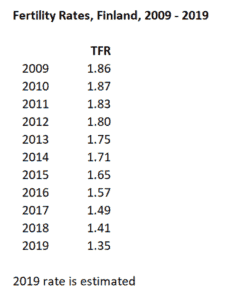Why Has Finland’s Fertility Rate Collapsed — And Are There Lessons for Us?
Elizabeth Bauer, Forbes, October 1, 2019
{snip}
“Not a single Finnish province will record more births than deaths 15 years from now unless the birth rate rebounds from its current record-low level, indicates a much anticipated population forecast published on Monday by Statistics Finland.”
As a reminder, this is Finland we’re talking about, not a country that ordinarily appears in discussions about ultra-low fertility rates. This isn’t Italy or Japan.
This is Finland, named the happiest country in the world in a 2019 ranking – and was #1 in 2018 as well, #5 in 2017 and 2016, #6 in 2015, #7 in 2013 (there was no 2014 report), according to the World Happiness Report researchers, who combine both objective and subjective measures of well-being and life satisfaction.
And Finland has generous levels of parental leave provision.
{snip}
After parental leave benefits end, a parent can stay at home, unpaid but with job protection, until the child’s third birthday, and receive a “child home care allowance.” Or parents can choose a daycare center and receive subsidies based on income, paying nothing for low-income families and up to a maximum of EUR 290 for one child, per month, for higher-income families.
{snip}
But yet, here’s the development of the fertility rate over the past decade (according to “Steep decline in the birth rate continued” at Statistics Finland and “The decline in the birth rate is reflected in the population development of areas” for the estimated 2019 rate):

{snip}
Is this due to a poor economy? Finland’s unemployment rate rose from a relative low of 7.7% in 2012 to a post-recession high of 9.4% in 2015 but has been declining since then, and now stands at a level of 6.7%, nearly again equal to its pre-recession low of 6.4% in 2008 – which itself is as low as its been since the end of the Cold War. The country’s real GDP growth rate had likewise dropped in the same timeframe, but then recovered and has only slowed slightly since then.
In an interview, Finnish Prime Minister Antti Rinne commented on the decline:
“’It’s a fact that parenthood has substantially reduced the pensions of women. Women’s careers and income development are the key issues we have to tackle to make sure those who are able and willing to start a family can do so. These are major issues,’ he commented.
{snip}
“’I’m concerned that maybe we’re not focusing on the right things if we’re not developing the services of families with children. We have to construct the entire service network in a way that families with children feel that they are supported,’ he underlined.”
{snip} What’s more, Finland was deemed to be the 4th most gender-equal country on the globe, according to the World Economic Forum’s analysis, behind only – you guessed it, Iceland, Norway and Sweden (Denmark, oddly, comes in at only 13).
{snip} But, as with Sweden, it calls into question the conventional wisdom that the path to replacement-level fertility rates is a combination of gender equality and generous social welfare provision.















